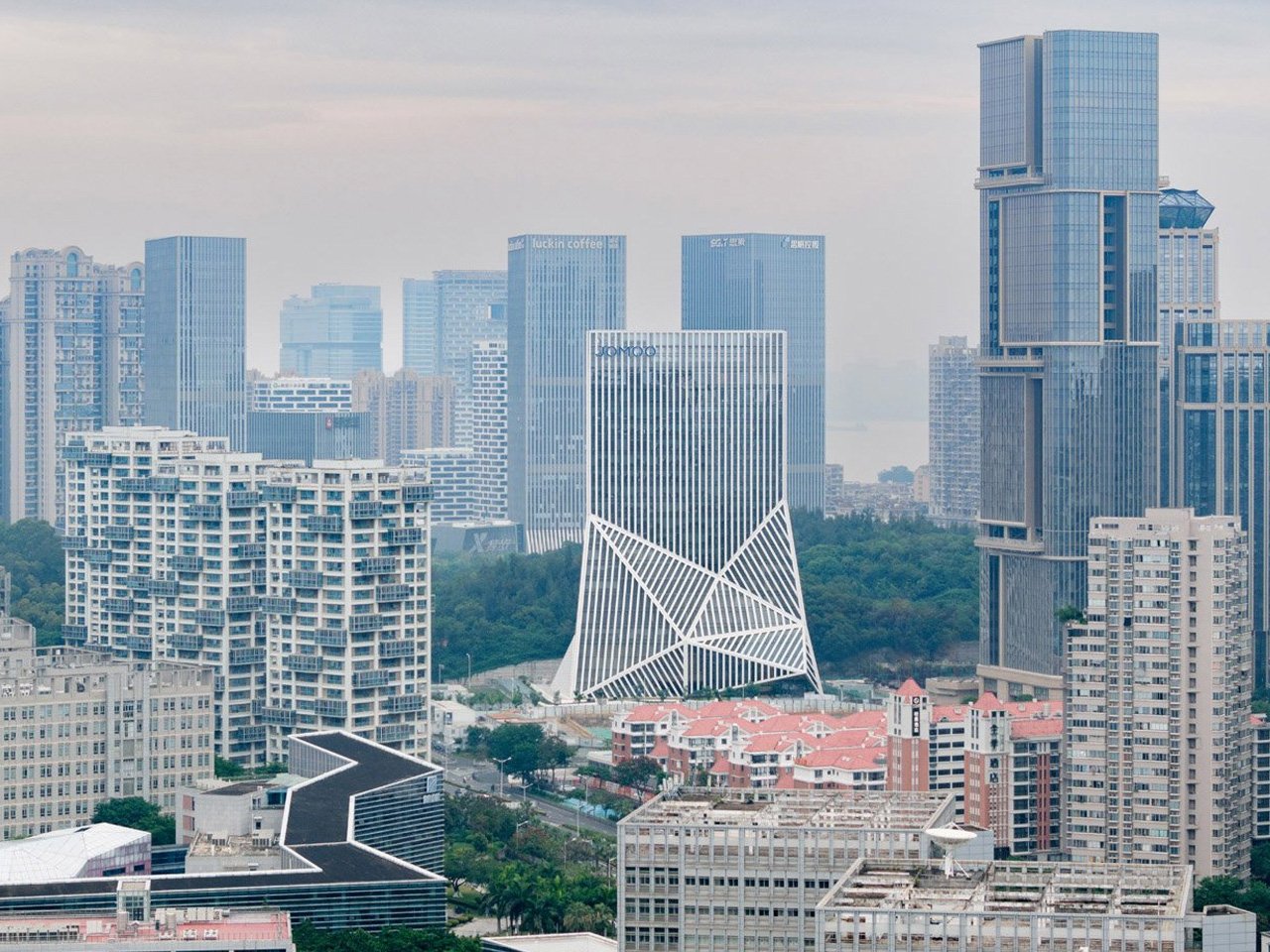Designed by OMA, the JOMOO Headquarters in Xiamen is a sculptural statement that feels both inevitable and surprising. The building, rising from the edge of the city’s central business district, marks a pivotal moment for JOMOO, China’s largest sanitaryware manufacturer, as it transitions from a national supplier to a global brand. OMA’s design language is less about spectacle and more about a thoughtful negotiation between city and landscape—a headquarters that is as much about presence as it is about context.
The base of the building is a monolithic volume, its irregular geometry inspired by the rocky topography that defines the Xiamen coastline. This grounding element anchors the campus, creating a civic front along the urban edge while gently receding into the forested hills. The base is a multi-functional platform that houses showrooms, public lobbies, and flexible spaces for recruitment and conferences. It’s a place where the company’s identity is made tangible, where visitors and employees move through a sequence of spaces that feel both open and protected.
Designer: OMA
Above this, the 230-meter tower emerges, wrapped in white ceramic stripes that shimmer in the changing light. The facade is designed to be a technical solution that eliminates the need for interior columns, allowing for flexible, open-plan office floors. The stripes echo JOMOO’s modular ethos, a tribute to the company’s future-oriented production methods. The tower’s sculptural form is a direct response to its surroundings, reinterpreting the prevailing high-rise typology that has shaped much of China’s recent urban expansion.
The interior is a mix of adaptability and transparency. Offices are organized to maximize daylight and views, while public-facing spaces are seamlessly integrated at the lower levels. The end result is a building that feels porous, inviting the city in rather than shutting it out. OMA teamed up with local architect Huayi Design to create innovative structural and mechanical systems, ensuring the headquarters is both a workplace and a civic landmark.
The JOMOO headquarters is blessed with the ability to bridge scales and experiences. From a distance, the headquarters reads as a powerful and singular object. Up close, its details—ceramic stripes, irregular base, generous glazing—reveal a sensitivity to material and light. It serves as a study in contrast: urban and natural, solid and transparent, monumental and approachable. It’s a headquarters that doesn’t just house a company, but embodies its aspirations.
OMA’s JOMOO Headquarters is not a building that shouts for attention, but one that rewards a second look. It’s a place where architecture becomes a tool for the transformation of a company, a city, and the way we think about work. The design is a reminder that the best headquarters are not just symbols, but living frameworks for growth, connection, and possibility.
FAQs
1. How does architecture influence workplace culture?
When we look at the JOMOO Headquarters, we can see that architecture directly shapes workplace culture by fostering openness, adaptability, and connection. The building’s open-plan office floors, made possible by a column-free structure, encourage collaboration and transparency among teams. Generous glazing and integrated public spaces bring in natural light and views, creating an uplifting environment that supports well-being and productivity. The design invites both employees and visitors to engage with the company’s identity, making the headquarters a hub for innovation and shared purpose.
2. How do headquarters designs reflect a company’s brand?
OMA’s design for the JOMOO Headquarters is a physical manifestation of JOMOO’s evolution from a national supplier to a global brand. The sculptural tower, wrapped in white ceramic stripes, echoes the company’s commitment to innovation, modularity, and forward-thinking production. The building’s strong yet approachable form signals ambition while remaining rooted in its local context, bridging city and nature.
3. What trends are shaping modern office architecture?
JOMOO Headquarters embodies several key trends in modern office architecture. Flexibility is central: open, modular spaces support evolving work styles and organizational needs. The integration of nature—seen in the building’s relationship with Xiamen’s rocky landscape and forested hills—reflects a growing emphasis on biophilic design. Facade innovation, such as the use of ceramic stripes, merges technical performance with visual identity.
The post Modern Skyscraper Office Combines Ceramic Facade & Flexible Design For A Distinct Corporate Identity first appeared on Yanko Design.

